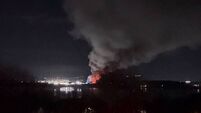Unsplattered windscreens a sign of low insect numbers

This decline puts the survival of our entire European ecosystem at risk, boding mass extinctions, as multiple species of bird, mammals, and amphibians starve. Human food shortages would follow, as crops fail to be pollinated.
I have no statistics for loss of winged insects in Ireland, but their decline has, for some years now, been clear to me, whenever I sit at an outside light at night or look at our yard light. The insects aren’t there — and the bats have gone, evidence of a widening circle of consequences.
But the most striking evidence for me is the recently dubbed ‘windscreen phenomenon’. In the last eight or ten years, whenever I take a summer evening drive, the clear glass in front of my face attests to a dramatic change in the world in recent decades.
I remember, as a child, my father getting out of the car to scrape away the insect corpses on the windscreen and headlights. I recall, later, in Dorset, in the 1960s, driving along summer lanes with the orange, green, white and blue innards of insects making my windscreen look like a painting by Jackson Pollock.
On summer visits to Ireland, I recall stopping to wash my windscreen at motorway filling stations, and, again, between Rosslare and my parent’s home in Kilkenny. It was the same all across Europe, when we went on long- distance adventures, the loud clunks of bumble bees or dragonflies hitting the glass on the autobahns. Our speed cost the lives of myriad creatures. Every car, every truck, took a similar toll. Flying insects were daily slaughtered by the million.
However, there were billions more in the air. What a shock, then, to see that now, even on warm, windless summer evenings, my windscreen accumulates no corpses. How dramatically this brings home the extent of the losses across all species, not just the insects. The eradication of insects, basic links in the food chain, threatens total extinctions.
A clear windscreen strikes me as a graphic paradigm of a lost world, where the very air teemed with life. Insects in their billions provided food for myriad creatures just a few decades ago. Now, they are gone and won’t be returning ‘anytime soon’ or, perhaps, never.
What, on Earth, have we done?
One evening last summer, I asked a friend and ardent nature watcher, Kevin Hanly, if he’d noticed that, in the last few years, no insects splattered the windscreen of his car. He had. ‘And what did it mean’? I asked.
It would mean, we thought, fewer insectivore birds, swallows and their kin, flycatchers, warblers — even the seed-eaters, like chaffinches, will eat certain flies.
I recalled mitching from school and sitting by the river Robe in County Mayo, idly watching chaffinches swoop from riverside trees and take mayflies as they rose, new-born, from the sparkling river. After a while, I began to count how many mayfly survived out of every ten. That truant day, the counting initiated me into the role of amateur naturalist.
Last week, I read that mayfly have declined by 80% in UK rivers; low-level pollution kills their eggs. The adults are an important item in the diet of fish, birds, small mammals. The eggs are laid on the river bed and survive over winter to hatch, live, as ‘adults’ for a day and lay another generation. Fine sediment suffocates the eggs, while as little as 0.07mg of phosphate per litre in the river sets back their development.
What kills the bees, butterflies, midges, etcetera, is less clear, but the German researchers are zoning in on one possible explanation. “Pesticide usage, year-round tillage, increased use of fertilisers, and frequency of agronomic measures... may form a plausible cause.” They stress the importance of chemical-free habitat, wild-flower rich ‘borders’ around farmland, and minimising the inimical side-effects of intensive agriculture. In the USA, entomologists estimate that insects annually provide $57bn worth of agricultural services, burying animal dung, preying on pests and, most importantly, pollinating the pollinator-dependent crops increasingly grown for food, fibre, and fuel.
Meanwhile, would that the winged insects of summer were legion as the starlings nightly performing their synchronised murmurations at Timoleague, West Cork, wheeling in dark shapes, as big as Graf Zeppelins, over the fields, with a hunting peregrine hopelessly diving amongst them, as filmed by Peter Wolstenholme. They’ve deservedly become stars of the press, radio, and TV.













